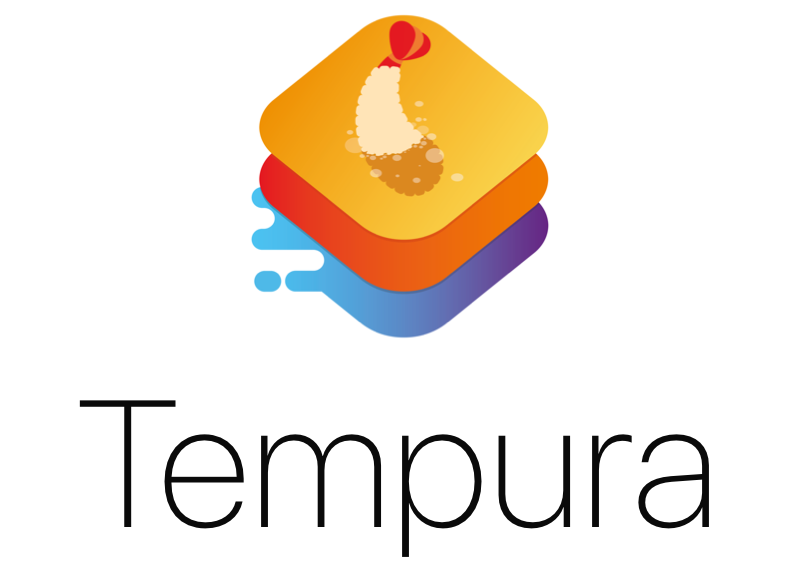Tempura 是一种全面的 iOS 开发方法,它借鉴了 Redux(通过 Katana)和 MVVM 的概念。
🎯 安装
Tempura 通过 CocoaPods 提供。
要求
- iOS 11+
- Xcode 11.0+
- Swift 5.0+
CocoaPods
CocoaPods 是 Cocoa 项目的依赖管理器。您可以使用以下命令安装它
$ sudo gem install cocoapods为了使用 CocoaPods 在您的 Xcode 项目中集成 Tempura,您需要创建一个包含以下内容的 Podfile
use_frameworks!
source 'https://cdn.cocoapods.org/'
platform :ios, '11.0'
target 'MyApp' do
pod 'Tempura'
end现在只需运行
$ pod installSwift 包管理器
自版本 9.0.0 以来,Tempura 亦支持 Swift Package Manager (SPM)。
🤔 为什么我应该使用这个?
Tempura 允许您
- 模型化应用状态
- 定义可以改变它的动作
- 创建 UI
- 享受状态和UI之间的自动同步
- 发货,迭代
我们开始在弯曲勺子的小团队内部使用Tempura。它为我们工作得非常好,以至于我们最终开发并维护了超过二十个高质量的APP,去年有超过1000万活跃用户使用这种方法。崩溃率和开发时间下降,用户参与度和质量提高。我们非常满意,想与iOS社区分享这一消息,希望您也能像我们一样兴奋。
👩💻 给我看看代码
Tempura使用Katana来处理应用逻辑。APP状态由单个结构体定义。
struct AppState: State {
var items: [Todo] = [
Todo(text: "Pet my unicorn"),
Todo(text: "Become a doctor.\nChange last name to Acula"),
Todo(text: "Hire two private investigators.\nGet them to follow each other"),
Todo(text: "Visit mars")
]
}您只能通过状态更新器操作状态。
struct CompleteItem: StateUpdater {
var index: Int
func updateState(_ state: inout AppState) {
state.items[index].completed = true
}
}屏幕UI所需的状态部分由ViewModelWithState选择。
struct ListViewModel: ViewModelWithState {
var todos: [Todo]
init(state: AppState) {
self.todos = state.todos
}
}应用每个屏幕的UI由ViewControllerModellableView组成。它公开回调(我们称之为交互),表示发生了用户操作。它根据ViewModelWithState渲染自身。
class ListView: UIView, ViewControllerModellableView {
// subviews
var todoButton: UIButton = UIButton(type: .custom)
var list: CollectionView<TodoCell, SimpleSource<TodoCellViewModel>>
// interactions
var didTapAddItem: ((String) -> ())?
var didCompleteItem: ((String) -> ())?
// update based on ViewModel
func update(oldModel: ListViewModel?) {
guard let model = self.model else { return }
let todos = model.todos
self.list.source = SimpleSource<TodoCellViewModel>(todos)
}
}每个应用屏幕由ViewController管理。默认情况下,它将自动监听状态更新并保持UI同步。ViewController的唯一其他职责是监听来自UI的交互并将动作分发给更改状态。
class ListViewController: ViewController<ListView> {
// listen for interactions from the view
override func setupInteraction() {
self.rootView.didCompleteItem = { [unowned self] index in
self.dispatch(CompleteItem(index: index))
}
}
}注意,ViewController的dispatch方法与由 Katana store 公开的略有不同:它接受简单的Dispatchable且不返回任何内容。这样做是为了避免在ViewController中实现逻辑。
如果交互处理程序需要执行多项操作,请将所有这些逻辑打包在副作用中并分发。
对于极少数需要在小控制台中包含一些逻辑的情况(例如在无需完全重构所有逻辑的情况下更新旧应用)您可以使用以下方法:
open func __unsafeDispatch<T: StateUpdater>(_ dispatchable: T) -> Promise<Void>open func __unsafeDispatch<T: ReturningSideEffect>(_ dispatchable: T) -> Promise<T.ReturningValue>
然而请注意,强烈不鼓励使用这些方法,它们将在将来的版本中移除。
导航
真正的应用是由多个屏幕组成的。如果一个屏幕需要展示另一个屏幕,它的ViewController必须符合RoutableWithConfiguration协议。
extension ListViewController: RoutableWithConfiguration {
var routeIdentifier: RouteElementIdentifier { return "list screen"}
var navigationConfiguration: [NavigationRequest: NavigationInstruction] {
return [
.show("add item screen"): .presentModally({ [unowned self] _ in
let aivc = AddItemViewController(store: self.store)
return aivc
})
]
}
}然后您可以使用ViewController中的导航操作来触发展示。
self.dispatch(Show("add item screen"))有关导航的更多信息,请参阅这里
ViewController包含
您可以在ViewController内部嵌套其他ViewController,如果您想重用它的一部分UI及逻辑,这会非常方便。为了实现这一点,在父ViewController中您需要提供一个ContainerView,它将接收子ViewController的视图作为子视图。
class ParentView: UIView, ViewControllerModellableView {
var titleView = UILabel()
var childView = ContainerView()
func update(oldModel: ParentViewModel?) {
// update only the titleView, the childView is managed by another VC
}
}然后,在父ViewController中,您只需添加子ViewController
class ParentViewController: ViewController<ParentView> {
let childVC: ChildViewController<ChildView>!
override func setup() {
self.childVC = ChildViewController(store: self.store)
self.add(childVC, in: self.rootView.childView)
}
}所有自动化设置都会自动完成。现在您将在ParentViewController中拥有一个ChildViewController,子ViewController的视图将托管在childView中。
📸 UI 快照测试
Tempura具有一个快照测试系统,可用于捕获您的视图在所有可能状态、所有设备和所有支持的语言下的屏幕截图。
使用说明
您需要在应用测试目标中包含TempuraTesting pod
target 'MyAppTests' do
pod 'TempuraTesting'
end在您的plist中指定截图的放置位置
UI_TEST_DIR: $(SOURCE_ROOT)/Demo/UITests在Xcode中创建一个新的UI测试用例类
文件 -> 新建 -> 文件... -> UI 测试用例类
在这里,您可以使用test函数对具有特定ViewModel的ViewControllerModellableView进行快照。
import TempuraTesting
class UITests: XCTestCase, ViewTestCase {
func testAddItemScreen() {
self.uiTest(testCases: [
"addItem01": AddItemViewModel(editingText: "this is a test")
])
}
}标识符将定义文件系统中快照图像的名称。
您还可以通过上下文参数个性化视图渲染方式(例如,您可以嵌套视图到UINavigationController实例中)。以下是一个将视图嵌入到标签栏中的示例。
import TempuraTesting
class UITests: XCTestCase, ViewTestCase {
func testAddItemScreen() {
var context = UITests.Context<AddItemView>()
context.container = .tabBarController
self.uiTest(testCases: [
"addItem01": AddItemViewModel(editingText: "this is a test")
], context: context)
}
}如果在UIScrollView中的重要内容没有完全可见,则可以借助scrollViewsToTest(in view: V, identifier: String)方法。这将产生额外的快照,渲染每个返回的UIScrollView实例的完整内容。
在这个示例中,我们使用scrollViewsToTest(in view: V, identifier: String)来捕获屏幕底部情绪选择器的扩展快照。
func scrollViewsToTest(in view: V, identifier: String) -> [String: UIScrollView] {
return ["mood_collection_view": view.moodCollectionView]
}如果您必须在渲染UI和捕获截图之前等待异步操作,则可以借助isViewReady(view:identifier:)方法。例如,这里我们等待显示远程URL图片的假设视图准备工作。当图片显示(即,状态为loaded)时,则进行快照。
import TempuraTesting
class UITests: XCTestCase, ViewTestCase {
func testAddItemScreen() {
self.uiTest(testCases: [
"addItem01": AddItemViewModel(editingText: "this is a test")
])
}
func isViewReady(_ view: AddItemView, identifier: String) -> Bool {
return view.remoteImage.state == .loaded
}
}一旦快照被捕获,测试将通过。
上下文
您可以通过传递给 uiTest 方法的 context 对象来启用多个高级特性。
container允许您在 UITests 期间将 VC 定义为视图的容器。基本的navigationController和tabBarController已经提供,或者您可以使用custom来自定义一个。hooks允许在发生某些生命周期事件时执行操作。可用的挂钩包括viewDidLoad、viewWillAppear、viewDidAppear、viewDidLayoutSubviews和navigationControllerHasBeenCreated。screenSize和orientation属性允许您定义测试期间要使用的自定义屏幕大小和方向。renderSafeArea允许您定义是否在测试期间将安全区域渲染为半透明的灰色叠加层。keyboardVisibility允许您定义是否将灰色叠加层渲染为键盘的占位符。
多设备
默认情况下,测试只在你从 Xcode (或你的设备,或 CI 系统中) 选择设备上运行。我们可以使用如下脚本来在所有设备上运行快照:
xcodebuild \
-workspace <project>.xcworkspace \
-scheme "<target name>" \
-destination name="iPhone 5s" \
-destination name="iPhone 6 Plus" \
-destination name="iPhone 6" \
-destination name="iPhone X" \
-destination name="iPad Pro (12.9 inch)" \
test测试将在所有设备上并行运行。如果您想更改行为,请参阅 xcodebuild 文档。
如果您想在 UI 测试中测试特定语言,可以将 test 命令替换为 -testLanguage <ISO code639-1>。应用将以此语言启动,并使用该区域设置执行 UITests。例如:
xcodebuild \
-workspace <project>.xcworkspace \
-scheme "<target name>" \
-destination name="iPhone 5s" \
-destination name="iPhone 6 Plus" \
-destination name="iPhone 6" \
-destination name="iPhone X" \
-destination name="iPad Pro (12.9 inch)" \
-testLanguage it远程资源
经常发生 UI 需要显示远程内容(即远程图像、远程视频等)。在执行 UITests 时,这可能是一个问题,因为:
- 网络或服务器问题可能导致测试失败。
- 系统应在远程资源加载时进行跟踪,将它们放入 UI,然后再截图。
为了解决这个问题,Tempura 提供了一个名为 URLProtocol 的子类 LocalFileURLProtocol,它尝试从您的本地包加载远程文件。
想法是在您的(测试)包中放入所有需要渲染 UI 的资源,而 LocalFileURLProtocol 将尝试加载它们而不是进行网络请求。
对于给定的 URL,LocalFileURLProtocol 使用以下规则匹配文件名:
- 搜索与 URL 同名的文件(例如,http://example.com/image.png)
- 搜索与最后一个路径组件同名的文件(例如,image.png)
- 搜索最后一个路径组件不带扩展名的文件名(例如,image)
如果无法检索到匹配的文件,则执行网络调用。
要在您的应用程序中注册 LocalFileURLProtocol,您必须在测试生命周期中尽快调用以下 API。
URLProtocol.registerClass(LocalFileURLProtocol.self)请注意,如果您使用的是 Alamofire,则可能会导致无法正常工作。请在此 找到相关问题和配置Alamofire以处理 URLProtocol 类的链接。
使用 ViewController containment 进行 UI 测试
ViewTestCase 主要用于测试带有自动注入代表着视图测试条件的 ViewModel 的 ViewControllerModellableView。
如果您使用的是 ViewController containment(如上面的 ParentView 示例),则在注入 ViewModel 时,视图的一部分将不会更新,因为存在另一个 ViewController 负责这部分。
在这种情况下,您需要使用 ViewControllerTestCase 协议在 ViewController 层级上进行扩展和测试。
class ParentViewControllerUITest: XCTestCase, ViewControllerTestCase {
/// provide the instance of the ViewController to test
var viewController: ParentViewController {
let fakeStore = Store<AppState, EmptySideEffectDependencyContainer>()
let vc = ParentViewController(store: testStore)
return vc
}
/// define the ViewModels
let viewModel = ParentViewModel(title: "A test title")
let childVM = ChildViewModel(value: 12)
/// define the tests we want to perform
let tests: [String: ParentViewModel] = [
"first_test_vc": viewModel
]
/// configure the ViewController with ViewModels, also for the children VCs
func configure(vc: ParentViewController, for testCase: String, model: ParentViewModel) {
vc.viewModel = model
vc.childVC.viewModel = childVM
}
/// execute the UI tests
func test() {
let context = UITests.VCContext<ParentViewController>(container: .none)
self.uiTest(testCases: self.tests, context: context)
}
}如果您没有要配置的子 ViewController,那就更简单了,您不需要提供 configure(:::) 方法。
class ParentViewControllerUITest: XCTestCase, ViewControllerTestCase {
/// provide the instance of the ViewController to test
var viewController: ParentViewController {
let fakeStore = Store<AppState, EmptySideEffectDependencyContainer>()
let vc = ParentViewController(store: testStore)
return vc
}
/// define the ViewModel
let viewModel = ParentViewModel(title: "A test title")
/// define the tests we want to perform
let tests: [String: ParentViewModel] = [
"first_test_vc": viewModel
]
/// execute the UI tests
func test() {
let context = UITests.VCContext<ParentViewController>(container: .tabbarController)
self.uiTest(testCases: self.tests, context: context)
}
}🧭 从这里开始
示例应用程序
该存储库包含了一个用 Tempura 实现的任务清单应用程序的演示。要生成 Xcode 项目文件,您可以使用 Tuist。运行 tuist generate,打开项目并运行 Demo 目标。
查看文档
📄 Swift 版本
Tempura 的某些版本仅支持某些 Swift 版本。根据您的项目使用的 Swift 版本,您应使用 Tempura 的特定版本。使用此表来检查您需要的 Tempura 版本。
| Swift 版本 | Tempura 版本 |
|---|---|
| Swift 5.0 | Tempura 4.0+ |
| Swift 4.2 | Tempura 3.0 |
| Swift 4 | Tempura 1.12 |
📬 取得联系
如果您有任何 疑问 或 反馈,我们很乐意在 [email protected]听到您的声音。
🙋♀️ 贡献
- 如果您 发现了错误,请创建一个问题;
- 如果您有 功能请求,请创建一个问题;
- 如果您 想要贡献,请提交一个拉取请求;
- 如果您 有关于改进框架或传播知识的好想法,请 联系我们;
- 如果您想 尝试将该框架用于您的项目 或编写一个演示,请发送 repo 的链接。
👩⚖️ 许可证
Tempura遵循MIT许可证。
❓ 关于
Tempura由Bending Spoons维护。我们创建了自身的技术产品,这些产品被世界各地数百万人所使用和喜爱。听起来很酷?了解我们





